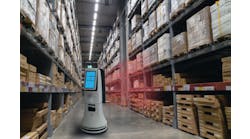Ericsson and Comau teamed up to show a 5G-powered digital twin at Hannover. Through a virtual-reality headset, visitors could move along a digital automotive assembly line, monitoring key parameters of the processes and of the machines in real-time.
By Keith Larson
Whether you prefer the term Industry 4.0 or digital transformation, the availability of new, digitally-driven tools to enable leaner, more agile and ultimately more profitable industrial operations remained front and center at this year’s spring tradeshows.
Your intrepid reporter visited two major industrial automation tradeshows on two continents—Germany’s Hannover Fair and Automate, held this year in Chicago. And while there was no shortage of IIoT platform enhancements, AI agents and data analytics suites, two particularly active technology fronts were 5G wireless networks and robotics.
Robots and cobots were all the rage at Automate, where it was hard to walk down an aisle without running into another new cobot arm or autonomous mobile robot (AMR). Actually, to be more precise, it was hard to walk down an aisle without having a cobot arm or AMR slow down on your approach, and stop respectfully as you came within its preprogrammed safety perimeter.
The 5G use case
But first let’s talk about 5G wireless—a far less “visible,” but potentially no less disruptive—innovation and a major theme at Hannover Fair. This year, the world’s largest industrial tradeshow even included a “5G Arena” where more than 20 telecom providers and traditional industrial players demonstrated why they’re making big bets on this high performance successor to the 4G/LTE technology that currently underlies commercial networks.
Almost universally, these companies claim that industry is the most compelling use case for 5G, and that its higher performance and reliability are key to industry’s continued digital reinvention. Indeed, 5G wireless networking combined with increasingly advanced robots is seen by many as key to allowing the increased mobility and modular flexibility demanded by the Industry’s 4.0 concept of batch size one.
Ultimate flexibility requires ultimate mobility of production equipment, and unplugging and reconnecting Ethernet cables is an admitted buzz-kill. Taking things a step further, Bosch Rexroth even envisions “intelligent spaces” that include not only wireless 5G networking for communications and control, but also wireless power: electricity delivered wirelessly, capacitively coupled through the floor.
The 5G standard continues to advance, but its current release (version 15) already allows for extremely low latency and high reliability of communications, according to Ewald Kuk, vice president of product management, industrial and rugged communication, security, identification and localization for Siemens. “Industrial companies can apply for their own industrial frequencies and start now to collect experience with private 5G,” Kuk said in a panel discussion “Industrial 5G in Practice” at Hannover.
The next iteration of the standard, which includes “5G Core” functionality is due later this year and will enable 8-millisecond response time as well as deterministic “slicing” of the signal, which is key to coordinating high speed robot performance, according to the panelists. Due for release in 2020 is version 16, which promises Ultra Reliable Low Latency Communication (URLLC): 1 millsecond latency, even on a public network. Full blown Time Sensitive Networking, or TSN, over wireless is scheduled for release 17, due to be completed in 2021.
Nokia powers 5G arena
Meanwhile, the 5G Arena at Hannover featured a live Nokia 5G network that allowed several leading industry players to present visionary 5G demonstrations. The showcases used Qualcomm mobile test devices to connect.
Demonstrations in the 5G Arena included:
- Bosch Rexroth—a human machine interface with 5G-enabled emergency stop capabilities
- Festo—predictive maintenance based on 5Gcollected data sets
- Götting—an automated guided vehicle (AGV) with live video streaming over 5G
- Phoenix Contact—replacing industrial Ethernet with 5G for process control
- Siemens—asset analytics in the cloud with various data points collected via 5G
- Weidmüller—an energy monitoring solution of the welding process in car manufacturing at Volkswagen
- Zeiss—a 5G-connected process quality control system for the automotive industry
“The smart, connected factories of the future will not only be able to make things, but make decisions too. We are very proud to support these live over-the-air demos with Nokia and European industry players to what 5G will make possible for industrial IoT,” said Enrico Salvatori, senior vice president and president, Qualcomm EMEA, Qualcomm Europe, Inc. “Qualcomm Technologies has been a key enabler in the industrial IoT for years, and we look forward, with 5G, to continuing to make Industry 4.0 a reality in Europe and around the world.”
“The fourth industrial revolution promises massive gains in productivity, disruptive customer experiences, and new business models,” added Kathrin Buvac, president of Nokia Enterprise and chief strategy officer. “Next generation networks, including 5G, will enable this industrial transformation and beyond with network reliability, capacity and low-latency features.”
Ericsson teams with ABB, Comau
Not to be outdone, Ericsson and ABB announced a memorandum of understanding that would accelerate realization of a joint vision for future flexible production enabled by automation and wireless communication. “Ericsson and ABB already have a strong collaboration in research for 5G and Industrial IoT technologies,” said Börje Ekholm, president and CEO, Ericsson said. “With this MoU, we strengthen our partnership to accelerate the industrial ecosystem and realize the full potential of flexible automation, unlocking new business opportunities enabled by combining 5G and Industry 4.0.”
The two partners are already fast-tracking the introduction of a new generation of intelligent factory technologies, with Ericsson deploying an intelligent automation system at its manufacturing facilities in Tallinn, Estonia. ABB has provided a fully automated flexible robotics cell solution that assembles 5G radios for Ericsson.
Ericsson also teamed with Italian industrial automation and robotics company Comau to show a 5G-powered digital twin at Hannover. The two companies showed the digitized version of an assembly line in an automotive plant. Using a virtual reality (VR) headset, visitors were immersed in the line and could “move” within it, monitoring the key parameters of the processes and of the machines, such as vibrations, temperature and pressures. A VR digital dashboard, which could be used with a standard tablet, identified situations that could create slowdowns or interruptions in the process by providing instructions to tackle the problem effectively.
“Comau’s new digitally interconnected equipment delivers real-time production data where and when it is needed, helping reduce downtime while improving overall quality,” said Maurizio Cremonini, Comau head of marketing and digital initiatives platform. “Digitized analytics provide customers with a wealth of information regarding production flows and throughput—information that is made available locally and remotely.”
Magnus Frodigh, head of research, Ericsson, added: “Bandwidth and low latency, main features of the new 5G technology, are the crucial factors that will allow us to accelerate the digitalization and automation of processes, enabling cutting-edge use cases in smart manufacturing and Industry 4.0.”
Scara intros feature low-cost, hygienic designs
Back at the biennial Automate event in Chicago, which in 2021 moves to Detroit, robot manufacturers were among the most visible and numerous exhibitors—from the perspective of new product introductions as well as sheer physical presence. Epson, for one, announced the expansion of its LS Series SCARA robot line with four new models, a new IntelliFlex parts-feeding system, as well as an “ultra low-cost,” all-in-one six-axis robot, the VT6L. This compact, easy-to-install robot is suitable for a wide range of simple applications and starts at only $13,900. “The VT6L was created based on the highly successful T-Series all-in-one design with built-in controller,” said Gregg Brunnick, director of product management for Epson Robots. “This innovation provides an easy-to-use six-axis solution at an ultra-low cost perfect for simple applications.”
These applications include parts transfer, such as machine-tool and injection molding load/unload, pickand-place, dispensing and simple assembly projects. The all-in-one design with built-in controller saves on valuable factory space while a compact wrist pitch enables access to hard-to-reach areas in confined spaces.
Stäubli, the Swiss maker of robots and textile machinery, also debuted a new family of SCARA robots to the U.S. market at Automate 2019. Called the TS2, the redesigned four-axis machines feature hollow shaft technology, which allows all the cables to be routed internally to create a hygienic design for use in sensitive environments.
“This new series of SCARA robots has been reimagined, incorporating our JCS drive technology that has greatly improved the performance and versatility of our six-axis machines,” said Sebastien Schmitt, robotics division manager, Stäubli North America. “This allows for ultra-short cycle times and enormous performance gains for the new four-axis TS2.”
“All media and signal connections are automatic,” added Schmitt. “There is no external bundling of cables and no irregular contours, and the new TS2s feature a completely sealed housing. The quill can be optionally protected with a cover and affixed with special screws and concealed connections can be housed under the robot pedestal. The TS2 offers the latest and greatest in hygienic design.”
Smarter, more muscular AMRs
In the category of autonomous mobile robots (AMRs), the upper end of the payload was extended to one ton (1,000-kg) with the introduction of the MiR1000 from Mobile Industrial Robots. Like the MiR500 before it, the MiR1000 is a collaborative, safe and flexible alternative to potentially dangerous and expensive fork lifts on the factory floor, according to MiR CEO Thomas Visti. MiR built the MiR1000 in response to strong demand from highly satisfied customers of the smaller robots who also want to transport heavy materials such as in the aerospace and automotive industries, Visti said.
“With the MiR1000, we are once again extending the possibilities for automating internal logistics, especially for those who want to transport very large materials without reconfiguring their infrastructure,” Visti said. “Manufacturers today must deal with ever-changing customer demands, which means they need flexible and easily adaptable production facilities. Conventional logistics solutions like forklifts and conveyor belts and even traditional automated guided vehicles (AGVs) haven’t been able to support this type of production.”
Also released at Automate 2019 was ROEQ’s TR1000 Top Roller, an automated conveyor designed to integrate seamlessly with the MiR1000 high-payload AMR. “A mobile robot without a conveyor or top module is like a robot arm without a gripper,” explained Peder Grejsen, technical sales manager for ROEQ. “Production throughput can be greatly improved when mobile robots are outfitted with intelligent top modules that self-load and unload.”
The TR1000 accommodates U.S. pallets and can be delivered with a fully automated lifter functionality for pick-up and delivery of goods in heights ranging from 23.6 inches (600mm) to 29.5 inches (750mm). The Top Roller integrates seamlessly in MiR’s own user interface where all control functions are embedded; when the robot is called to deliver or pick up goods, the conveyor communicates with the pick-up and delivery stations and will automatically activate the loading or unloading upon arrival.
“By targeting the loading and unloading of mobile robots, we are addressing that missing link in the automated logistics cycle that today is handled either by fork or pallet lifters or manually by employees,” said Grejsen. “Adding the conveyor capability strengthens the employees’ work environment by taking over ergonomically unfavorable tasks or by reducing truck traffic and noise.”
A unified, cross-platform approach
Relative newcomer Ready Robotics debuted its Forge/ OS and Forge/Ctrl offering at Automate 2019. The hardware controller and accompanying software are designed to bring a unified, cross-platform approach to robot programming and control. The Forge suite consists of a hardware controller (Forge/Ctrl) running robust software (Forge/OS), which together “empower anyone to intuitively control industrial and collaborative robots,” according to the company.
With a small installation footprint and an IP54 rating designed to withstand heavy industrial environments, Forge/Ctrl is intended to bring a plug-and-play experience to setting up robot hardware. Developers can easily plug in pneumatic peripherals, sensors, and all manner of grippers through standardized interfaces. Forge supports leading gripper brands like Piab, Schunk, and Robotiq. Forge/Ctrl even makes it possible to control older machine tools without complicated electrical integration.
Forge/OS software allows users to quickly and intuitively create sophisticated programs via touchscreen while controlling everything hooked up to the Forge/ Ctrl hardware. This includes a wide variety of peripherals, grippers, sensors and pneumatic devices. The Forge solution is field-tested, customer approved and available now on FANUC, and Universal Robots platforms with support for ABB, Denso, KUKA and Yaskawa to follow in the near future.
Dispelling cobot myths
Universal Robots showcased new cobot-powered solutions for machine tending, packaging, assembly, and processing at Automate 2019. The new applications were intended to debunk myths on what cobots can handle while also addressing industries experiencing hiring issues.
When U.S. manufacturers were asked to describe their primary business challenge, it wasn’t the increase of raw materials cost, trade uncertainties, or rising health insurance expenses that topped their lists, the company reported. Rather, close to 70% of manufacturers in the National Association of Manufacturers’ 2018 fourthquarter outlook survey responded that attracting and retaining a quality workforce was their number one concern while the Society of Manufacturing Engineers reported that 89% of manufacturers have difficulty finding workers.
The labor shortage is especially prevalent in jobs with many repetitive and ergonomically unfavorable tasks. “These are jobs that we like to refer to as the ‘3D jobs’ – the dirty, the dull and the dangerous,” said Stuart Shepherd, regional sales director for the Americas. “Collaborative robots are now increasingly handling these types of tasks in manufacturing settings. Our booth at Automate showcases how we work with our rapidly expanding partner network to develop solutions tailored to address the industries and applications hardest hit by labor shortages.”
The company’s booth demonstration of machine tending, packaging, assembly and processing applications was no coincidence. “We chose to focus on these applications as they are currently experiencing a significant demand for cobot automation,” said Shepherd. “These are also tasks where our cobots consistently deliver ROI of less than a year, often paying themselves back in a few months as cobots typically deploy up to 50 percent faster than traditional automation.”




